Managers Who Spent the Most Money in Football
You don't play on paper and you don't play with money. Yet one could say that managers who spent the most money in football are playing on easy mode.

Formations are so vital to the game some call football, the minority soccer, that often they are used almost synonymously with it. Magazines, big or small, are named with just the numbers suggesting the layout of the outfield players on the pitch. But what are the best soccer formations overall? What makes them great, what are their drawbacks, and which teams and coaches use them? We address all the basics of the specific soccer formations right below.
Firstly, stating the obvious. Formations are represented with numbers separated by dashes "-" which illustrate the lines of the team: defence, midfield, and attack. So usually there are three digits. Although sometimes four, as midfield units can be separated.
Of course, the digits must always add up to 10, because the goalkeeper is overlooked.
It’s important to note that none of these commonalities are natural laws, hence the formations differ from manager to manager, and often from game to game.
Most importantly, formations change during the game, often within the same minute. Especially going from offence to defence. Yet formations form the base on which a team operates, hence their importance remains high.
Best Soccer Formations Explained
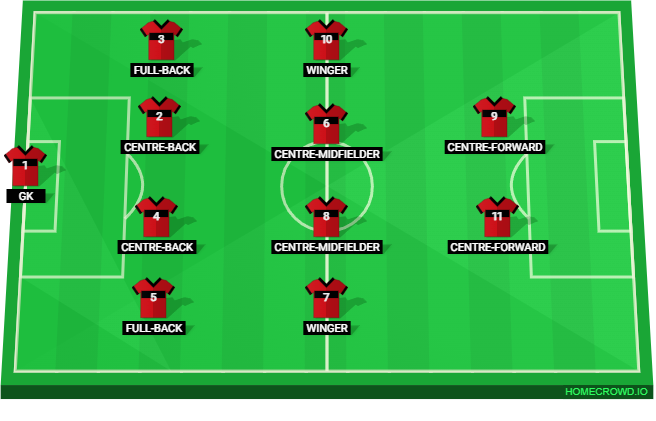
Arguably the most well-known soccer formation even though it’s not used as much as it was.
Yet the 4-4-2 became a staple in a period when football became ever-present and truly a massive phenomenon in the TV era.
It’s especially important in England as it was suited for a style of play most beloved in the country. To the point that the nation’s leading football magazine bears its name.
The 4-4-2 is beloved in England, but it was perhaps popularized in Italy, with Arrigo Sacchi's Milan.
More notably, it was utilized by Sir Alex Ferguson's Manchester United, and by Arsene Wenger's Arsenal.
Four-four-two is characterized by the attacking tandem of two full-backs and two centre-backs in the backline. Two central midfielders and two wingers in the midfield. And by the attacking tandem duo of centre-forwards.
The latter have the opportunity to cause numerical problems to the opposing team’s centre-backs, who were usually also just a pair of two. As opposed to a lone striker.
The 4-4-2 soccer formation is adept at wing play, with overlap of the full-backs a common theme at Manchester United and Arsenal of SAF and Wenger.
One of the two strikers would usually be a taller, target man, flicking on the other more agile one into dangerous zones. Or holding up play until midfielders join the final zone.
As the defensive and midfield lines are formed up the same, this provides for a strong compactness in defence.
If the strikers are involved in the defence, it leaves few spaces where the opposition can hold the ball without multiple points of pressure.
With such proximity of lines for the low block, the two usually pacey wingers, and two strikers who can play off each other, the 4-4-2 provided a strong option for counter-attacks.
All the reasons why Diego Simeone is one of the last great managers to use this tactic regularly.
The issue with the 4-4-2 is that there are just two central midfielders, which can be exploited by the tactics in which three midfielders are employed.
Additionally, in attack, it was common to see the lines disconnected from each other, due to being parallel.
As the midfield and defence lines are positioned parallel, the passing options can be easily limited. Unlike in formations where more natural triangles appear.
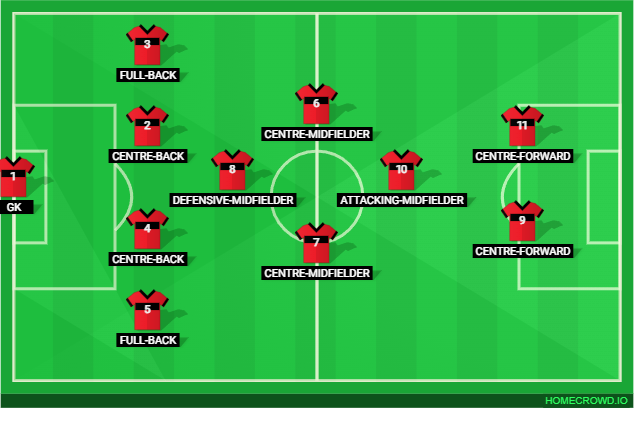
One such is the variation of the 4-4-2 formation - the 4-4-2 diamond. Where one central midfielder drops down towards the defence, and one goes forward towards the strikers.
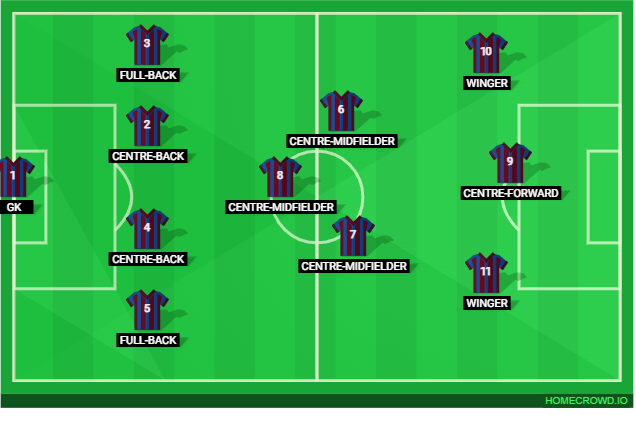
Going from a formation that ruled the soccer world, to the one that is dominating in 2024 and years prior.
Popularized by Rinus Michels' famed total football style, powered by 4-3-3, the formation is known for attacking, technical football. The primary sides that carried it were Ajax and Barcelona, in the 60s and 70s with Michels. In the following decade, Johan Cruyff employed it with the same teams.
Barca is further linked with the formation through Pep Guardiola's famed side that featured Lionel Messi, Luis Suarez, and Neymar as the last part of the 4-3-3.
One player is a classic striker, the two side ones are wingers or inside forwards.
Now, it's still Pep Guardiola's favourite formation at Man City, even though the coach is adamant formations are "just phone numbers" and that the real game is far too complex.
Yet there is a reason they exist.
For 4-3-3, the best trait is the three central midfield players. In a rock-paper-scissor situation, it usually dominates the 4-4-2 precisely because of it. Not that it means a certain victory by any means, but a domination in possession.
The basic shape of the 4-3-3 provides more natural triangles. Making it adept at keeping the possession as the ball-handler always has at least two options. For the midfield unit, they often provide it to themselves.
Defensively, the 4-3-3 provides the best option to press the opponents high up, as you're doing it with three attacking players.
While the compact midfield can provide a significant block to the opponents in the middle and the defensive end of the pitch.
The weakness of the 4-3-3 is that the central positioning of the midfielders leaves a lot of room on the flanks for the opponents to creep towards the defence.
This is especially the case if the full-backs push forward, which often leaves a counter-attacking highway to the box.
Additionally, the lone number nine can get swamped by two or even three centre-backs.
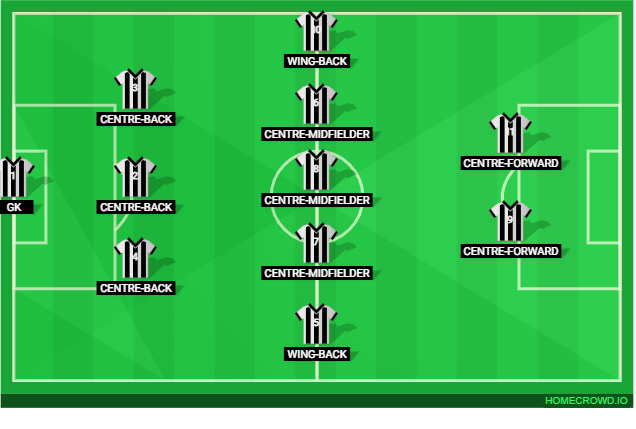
The 3-5-2 is one of the best soccer formations used frequently in the last decade. Most notably by Antonio Conte, who made Juventus into a dynasty with this setup.
It's characterised by a three-centre-back defence, two wing-backs, three central midfielders, and two forwards.
It especially requires ball-playing centre-backs. As the wing-backs would have to retreat too much back in order for the goalkeeper to employ them with the ball safely upon restarting play.
Wing-backs have fewer defensive responsibilities in a 3-5-2 formation, as the CB partnership has a third man and could, theoretically, face a stronger opposition.
Similar to a 4-4-2, the centre-forward partnership usually has one big man that's used as an anchor point for the direct balls forward. Either pushing onward alone or employing his teammates after guarding the possession until they get in his vicinity. Think of Romelu Lukaku at Conte's Inter.
The weakness of the 3-5-2 is the spaces left behind the wing-backs. It’s also incredibly hard for the recruitment teams to find wing-backs with enough stamina for the job, as well as centre-backs with proper ball-handling skills.
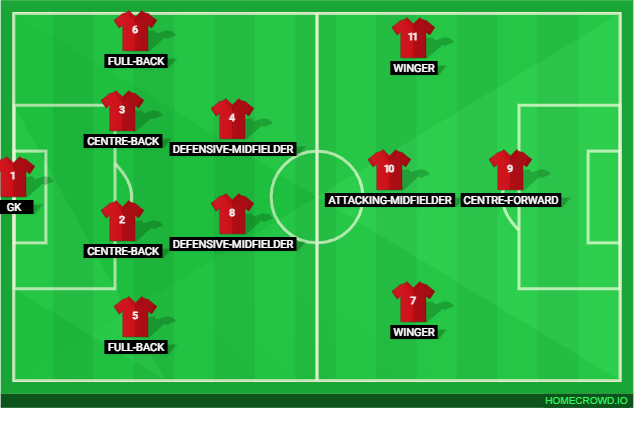
For a while in the 21st century, the 4-2-3-1 was the dominant formation. Yet it remains highly utilized in 2024 too.
Perhaps, the man who popularized it the most was Rafa Benitez, firstly with Valencia, and then with Liverpool.
However, the 2013 and 2020 Bayern Munich squads under Jupp Heynckes and Hansi Flick both won the Champions League trophies with it.
The 4-2-3-1 boats a flat backline, the two midfield pivots of two deep-lying midfielders, usually one more defensive, the other more creative. The attacking central midfielder, and two wide midfield players. Behind a lone striker.
The number 10 player, or the attacking midfielder, is key for the 4-2-3-1, as a transportation hub that connects the lines of the team.
In possession, the 10 can drop down closer to the CMs and provide a numerical advantage. While roaming outside of position to find space is also a common theme.
As the double midfield pivot has two bodies, it enables a strong block down the centre of the pitch. But also a faster cover of the lateral positions if the opponents try to go there, than if there was a single pivot.
The flaws are - as is common now - that there is only one forward, who can be swamped in a two-three line CB defence. But also that the presence of a double pivot means there is one less of a body in attack.
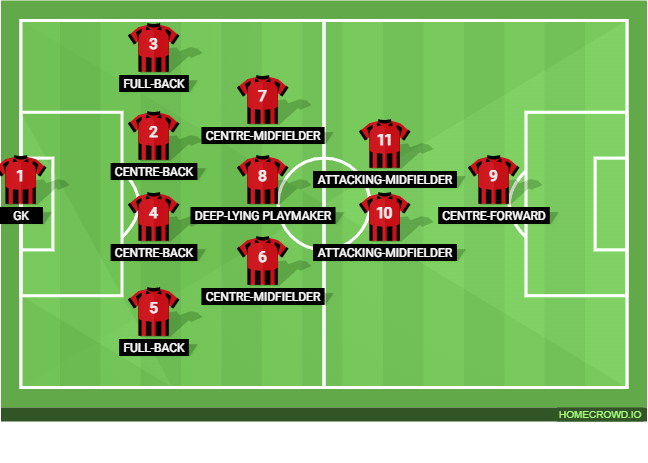
Perhaps no other formation is so synonymous with a single manager than the 4-3-2-1 with Carlo Ancelotti. It also has a cool nickname - the Christmas tree formation, as the lineup of players resembles its shape.
Ancelotti's AC Milan side is the torch-carrier for the formation that is less used today. With a flat back line, of two centre-backs and two full-backs, the lines of the Christmas tree keep narrowing down.
The midfield three consists of the central deep-lying playmaker. The architect. The two wider midfielders are mostly charged with ball-winning. But that is not all that they did. As both Ancelotti's enforcers, Massimo Ambrosini and Gennaro Gattuso, had the technical and tactical acumen to support the build-up play.
Ahead, the two attacking midfielders have the space to roam out in wide position, or to charge for goalscoring opportunities if the lone striker draws the defenders to the side.
The shape of the Christmas tree easily points out one of the major flaws - the lack of attacking width. As only full-backs are positioned closely to the sideline. Hence, attacking, speedy full-backs were a necessity.
Secondly, it's clear that the centre-forward is at a severe numerical disadvantage.
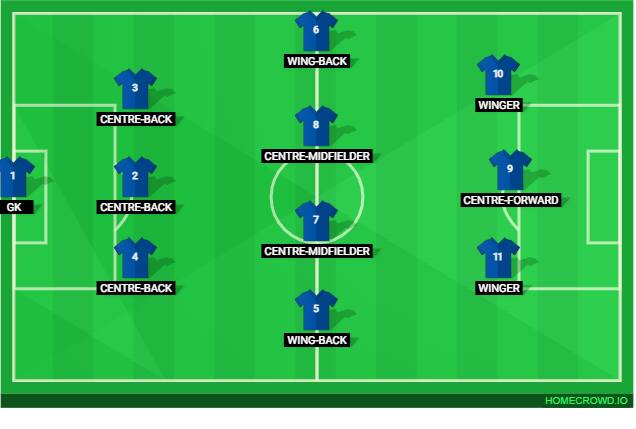
Although it might seem exotic at first glance, the 3-4-3 is employed frequently. Perhaps most notably by Thomas Tuchel's Chelsea squad.
With three centre-backs, two wing-backs, a double pivot in central midfield, two roaming 10s, and a striker, the 3-4-3 is quite versatile.
The power of the 3-4-3 is that of transformation, as in defence, it can smoothly revert to a 5 line defence, with a two in front. Meaning a defence of seven bodies. Or, the full-backs can go forward and you get an attack of five bodies at least.
While the wing-backs stretch the defence laterally, this opens space for the 10s and the 9 to exploit in the centre vertically.
Wing play is a natural flow of the 3-4-3, with the wing-backs often getting help from the roaming attacking midfielders.
The double pivot and the two 10s create a box shape in the middle of the pitch, which provides for options in sewing the flow of the ball better. Furthermore, one of the 10s can always retract back to form a three-men centre midfield.
Even when reverting to a back five, the team concedes the wide areas of the midfield to the opposing team for quicker pitch occupation.
Again, the two central midfielders can get outnumbered by a three-man midfield.
These best soccer formations should provide for a better framework to understand and enjoy the game. Yet it’s in their slight changes that true expertise lies.

You don't play on paper and you don't play with money. Yet one could say that managers who spent the most money in football are playing on easy mode.
Check out the salary and net worth of Rafa Benitez, one of the best and longest-working football managers in the game.
Even the best of the best sometimes get the axe in the ruthless game of managers, so check out all the times Rafa Benitez got sacked in his career. And why.
Considering that he always kept his demeanour reserved, it's surprising how much is known about Rafa Benitez's personal life.
What is a story of a person without conflict? See the most important rivals Rafa Benitez faced throughout his career and how he fared against them.